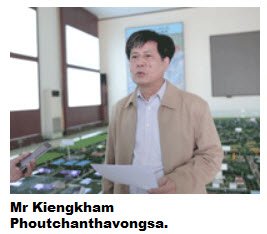Saysettha Development Zone to develop new eco-industry city
Saysettha Development Zone aims to develop a new eco-industrial city in which industrial, commercial, service and residential areas will be integrated as a cohesive, visionary project.

The zone was established in 2010 under a cooperative project between the governments of Laos and China.
It has been listed as a high priority project under China’s “Belt and Road Initiative” and listed as a significant development project for Laos.
The Saysettha Development Zone is located 17km to the northeast of Vientiane’s city centre and is one of 14 zones to be established under the government’s policy to develop special and specific economic zones.
The zone is operated by the Lao-China Joint Venture Investment Co., Ltd. and co-funded by the Yunnan Provincial Overseas Investment Co., Ltd. and the Vientiane Administration.
The overall functional scheme of the Zone is, One City and Four Areas, including the Vientiane new industrial eco-city, the international industry cooperation demonstration area between China-Laos cooperation, core areas of Vientiane new city and a livable residential area with a harmonious living environment.
Following the development model of industrial park and new city, industry and urban cities will be integrated. The city will become the foundation for the industrial space and will help develop the industrial economy, while industry will play a vital supporting role, driving urban renewal and improving support services.
So far, there has been progress in basic infrastructure development. Roads, water, electricity, communications and cable television have been established on 410 hectares of land, at a cost of more than US$300 million.
These facilities will satisfy the needs of businesses already based in the zone and will attract more investment to the area, Deputy General Manager of the Lao-China Joint Venture Investment Co., Ltd., Mr Kiengkham Phoutchanthavongsa, told Vientiane Times during a visit to the zone recently.
Saysettha Development Zone opened for all domestic and foreign investors and so far foreign investors from various countries have expressed their interest and came to collect information.
So far, around 35 Chinese and foreign companies have already moved into the zone, with an aggregate investment of about US$350 million.
They have invested in agricultural product processing, clean energy production, logistics, commerce and trade, machine manufacturing and industrial construction, he added.
Currently, a company producing animal food has already produced their product while a petroleum refinery project and a company producing knockdown houses are under construction.
Saysettha Development Zone aims to develop as a new eco-industry city which includes industrial, commercial, service and residential areas; therefore, we have to select companies to invest in the zone in compliance with our environmental policy, Mr Kiengkham said.
He noted that the company has three levels of environmental standards for companies and will accept only level 1 and 2 and refuse all companies operating their business at level 3.
The zone plans to create a waste treatment area before releasing it to the Mekong River to avoid environmental issues.
Along with success, Saysettha Development Zone has encountered obstacles in its period of development, especially land issues, as the government hasn’t handed over the entire land for development of 370 hectares.
Mr Kiengkham said another land issue is the government’s policy on the right of land use in development, as they know that industry development needs about 20-30 years for development.
The government has allowed the right of land use for 70 years and if compared with the development period, usage would remain for only 23-30 years, Mr Kiengkham said.
Saysettha Development Zone is a specific zone so they should have better promotion policy on tax and customs than the current investment promotion law to encourage more investors to move into the zone.
Another is the labour issue as despite the large quantity of workers they are still insufficient to meet the high demands for the labour market.
When we developed the zone as an industrial city, certainly the labour force should be available for industrial systems. Therefore, the limited number of those skilled workers is a big concern for the zone, Mr Kiengkham said.
The zone is currently preparing to develop residential land, including a hospital and school, in the second phase of project, he said.
In the second phase from 2016-2020 and the third phase from 2020-2030, the zone will mainly develop commerce and trade along with a focus on building a new part of Vientiane.
The zone expects to spend about US$650 million on infrastructure investment in three phases, on about 1,149 hectares of land, according to the company’s development plan.
There are a total of 14 special and specific economic zones in Laos, including four special economic zones and 10 specific economic zones.
The four SEZs are Savan-Seno SEZ in Savannakhet province, Golden Triangle SEZ in Bokeo province, Champassak provincial SEZ, and Phousy SEZ in Luang Prabang.
Specific economic zones include Boten Beautiful Land in Luang Namtha province, Pakxe-Japan SME in Champassak province, Thakhaek and the Phoukhiew SEZ in Khammuan province.
Specific economic zones in Vientiane are That Luang Marsh, Vientiane Industry and Trade Area (VITA Park) in Xaythany district, Xaysettha Development Area and Vientiane Long Thanh Golf Course in Xaysettha district, and Dongphousy 1 and 2 in Hadxaifong district, the Champa Nakhone SEZ and the Pakxe-Japan SME within the Special Economic Zone in Champasak province.
By Times Reporters
(Latest Update December 16, 2016)











